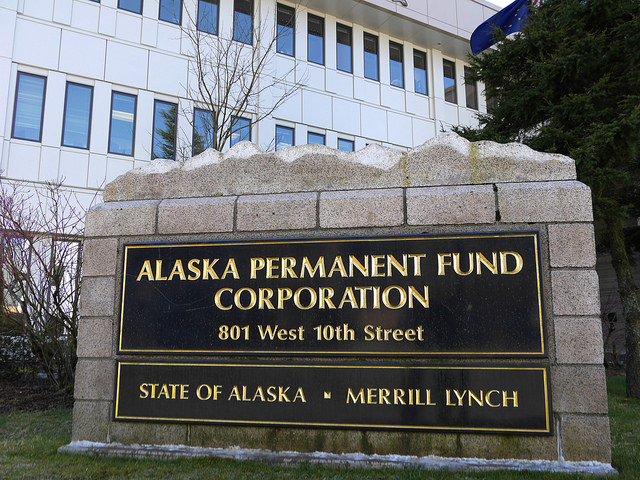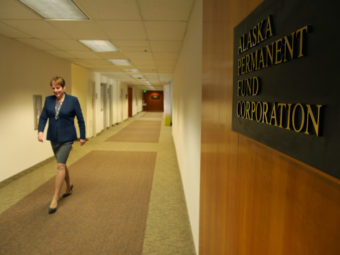
Alaska owns a massive investment account, and lately, it has been growing rapidly.
In the last fiscal year, Permanent Fund Corporation Chief Executive Officer Angela Rodell said the corporation is up 12.5 percent.
“We made $7 billion dollars,” she said.
Right after the last big global financial crisis in 2008, Alaska’s sovereign wealth fund had about $25 billion dollars in it. And today, Alaska’s Permanent Fund has $63 billion in it. It doubled in size in less than a decade.
Rodell highlights two things when she talks about the growth. The first, money grows money. The more you have, the more you make.
The second is a bit more complicated. The answer starts in 1976. That was the year Alaskans decided they wanted to put away some of their oil wealth.
Bob Maynard was a young oil and gas attorney with the state, working on the legal language that would eventually create the Permanent Fund. That language sticks out for him, because it’s one of the first things he brings up when asked about his decades working with and for the Permanent Fund corporation.

His big contribution?
“If you look at the opening phrase of the Permanent Fund amendment, it’s grammatically tough. A bunch of us were in the (Attorney General’s) office arguing about how you phrase that opening phrase. The mineral royalties, rents, etc. There’s no good way to do that. And, at one point someone put in an Oxford comma … And, I think I successfully argued to take that out.”
Maynard says he’s actually a fan of the Oxford comma. He just doesn’t like to see it misused.
So, when the fund was first created. The state kept it on a tight leash. Fund managers were only allowed to invest in things that were specifically written into state statute. And that list of things was short, Rodell said, real short.
“The list included bonds, treasury bonds. And that was it,” she said.
Treasury bonds are pretty safe, barring double-digit inflation it’s easy to count on getting your money back. Rodell says there’s nothing wrong with them but with low risk, comes low reward.
Over time the state loosened up the restrictions on investing the Permanent Fund. It took nearly ten years before managers were allowed to invest in stocks. Several years later, they were allowed to invest outside the U.S.
Maynard says it was a slow opening up to the market.
“Essentially, you’re investing with some hands partly tied behind your back,” he said.
Each time something new was added to that list, the fund took on more complex projects. Then, in 2005, the legislature finally got rid of the list. They replaced it with a mandate to invest responsibly.
This is the second moment Rodell points to as key to the fund’s explosive growth. Finally, investment managers were able to dig into some investments that that were riskier — but, came with greater rewards.
Now, the fund that grew from Alaska’s oil wealth is everywhere: stocks, bonds, real estate, hedge funds, infrastructure. It has also showered money on biotech companies doing cutting-edge drug and cancer research.
And, with each new deal, investors have to become experts in each type of investment.
Maynard spent decades with the Permanent Fund, watching this complex investment strategy unfold. Now, he’s the Chief Investment Officer at Idaho’s Public Employee Retirement System. He said, so far, Alaska’s Permanent Fund investment managers are holding their own.
“They keeping up with the competition … they’re in the pack of large, multi-billion dollar institutions and that’s a pretty fast pack,” he said.
But, in the long run, he wonders if the benefits of a complex investment strategy are worth the potential downsides. And, he isn’t just talking about the Permanent Fund, because what they’re doing is pretty standard.
“I tend to be a curmudgeon in the industry … the benefits of complexity have yet to be fully proven,” he said. “The argument for doing that is that the complexity does give a more stable, more broadly diversified platform that, when you have another collapse, the Permanent Fund will not be as exposed.”
But, he said that the more complex an investment strategy gets, the more moving parts, the more likely it is that something could go wrong.
Maynard is hardly the only one thinking about this. Lawmakers and Permanent Fund managers have been talking about this for decades.
But, looking beyond how the fund should be invested, Maynard said there are some built-in stumbling blocks in just being a state-owned fund.
“Just to keep up with the pack, you’ve got to be able to have the resources, the knowledge sources and the internal expertise,” he said.
There has been a lot of turnover at the corporation in the last decade. Maynard said that kind of brain-drain can make it difficult to maintain a complex strategy.
“If you have to continually refresh that expertise because people keep leaving, at some point, you may stumble on that,” he said.
Another potential issue is that all of those investment managers are state employees. Alaska’s in a recession. That means cost-cutting, de facto hiring freezes and travel bans.
And, they have state employee salaries. Some estimates are that Permanent Fund Corporation employees are paid about a quarter of what people in their same positions make in the rest of the country.
There is one final risk to highlight. It’s a big on one on Angela Rodell’s mind. In fact, a lot of people who watch the market are talking about.
“So there’s there’s the nervousness that happens when you’re hitting day after day record values,” she said. “When is this going to go wrong?”
The U.S. has been in this period of steady economic growth. Analysts call it a bull market. That bull has been running for a long time, nearly nine years. It’s the second longest run in history.
That’s when people like Rodell start worrying.
“So clearly, the thing we’re most concerned about is … that this robust market that we’ve all been watching for awhile now is going to have an event, like a tech bubble or a housing bubble,” she said.
That market correction could be incredibly painful for Alaska’s bottom line.
The last time the housing bubble popped, the country slid into a recession and the Permanent Fund took a big hit.
If the same thing happened again, the fund could lose more than a third of its value.
